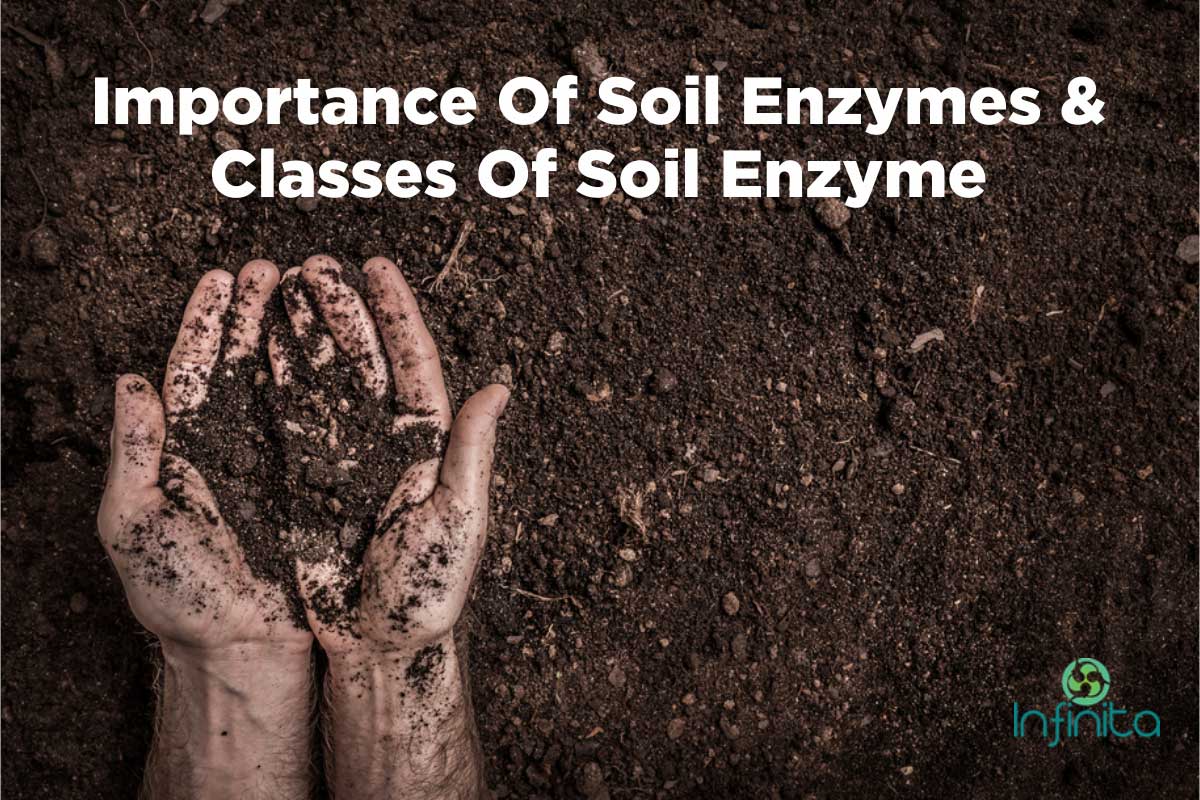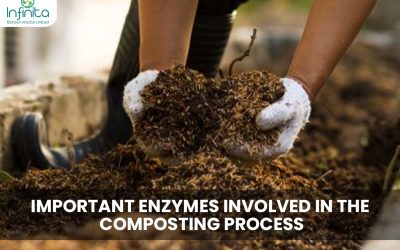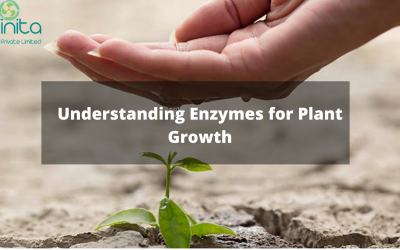
Soil Enzymes : Their Importance And Classes
Importance Of Soil Enzymes & Classes Of Soil Enzymes
Introduction
Soil is the place where all natural and anthropogenic activities necessary to the life of humans, animal, and plants occur. Forests, plants, grasses, crops grow on soil; superficial water basins and rivers are and flow on soil; animals spend their life and move on soil, between cycles of incorporation of food and release of droppings, these latter contributing to the normal recycling of soil and its nutrients. Soil is where humans have established their residence and built all structures necessary for their life.
Soil is also the place where hazardous residues deriving from anthropic activities are very often released with dangerous and frequently irreversible effects on its safety and consequently human health. Often these human activities have produced desertification, deficit or even loss of biodiversity, alteration of the soil matrix, deficiency of organic matter and nutrients. It appears therefore evident as what happens on and within soil is of paramount importance for maintaining soil health and productivity and consequently for a balanced and integrated life on earth.
An equilibrated, safe and productive soil exists when its biological, biochemical, physical and chemical properties, all correlated to each other, contribute to sustain all activities occurring in it. Among these properties the activities of soil enzymes play a fundamental role because they mediate numerous chemical reactions involved in soil nutrient cycling; transformation of plant and microbes’ debris; mineralisation and transformation of organic matter within the carbon cycle, transformation and degradation of potentially hazardous pollutants, thus contributing to the restoration and remediation of polluted soils.
Therefore, soil enzymes are involved and assist all activities fundamental to agricultural sciences and as such they may be used as useful and suitable indicators of microbial nutrient demand and soil health and quality. This research has been conducted by Infinita Biotech
Complexity of Enzyme Activity in soil
Soil enzymes increase the reaction rate at which plant residues decompose and release plant available nutrients. The substance acted upon by a soil enzyme is called the substrate. For example, glucosidase (soil enzyme) cleaves glucose from glucoside (substrate), a compound common in plants. Enzymes are specific to a substrate and have active sites that bind with the substrate to form a temporary complex. The enzymatic reaction releases a product, which can be a nutrient contained in the substrate.
Sources of soil enzymes include living and dead microbes, plant roots and residues, and soil animals. Enzymes stabilised in the soil matrix accumulate or form complexes with organic matter (humus), clay, and humus-clay complexes, but are no longer associated with viable cells. It is thought that 40 to 60% of enzyme activity can come from stabilised enzymes, so activity does not necessarily correlate highly with microbial biomass or respiration.
Therefore, enzyme activity is the cumulative effect of long term microbial activity and activity of the viable population at sampling. However, an example of an enzyme that only reflects activity of viable cells is dehydrogenase, which in theory can only occur in viable cells and not in stabilised soil complexes.
There are 2 types of enzymes:
-
Constitutive
Always present in nearly constant amounts in a cell (not affected by addition of any particular substrate…genes always expressed.) (pyro-phosphatase).
-
Inducible
Present only in trace amounts or not at all, but quickly increases in concentration when its substrate is present. (Amidase).
Both enzymes are present in the soil.
Classification of enzymes by their pH optima and variation with soil pH
| Group | Enzyme | Optimum pH range |
| Acidic consistent among soils | cellobiohydrolase | 4.0-4.5 |
| β-xylanase | 4.5-5.5 | |
| arylsulphatase | 3.0 | |
| Acidic – sub-acidic, variable with soil pH | α-glucosidase | 3.0-7.0 |
| β -glucosidase | 3.0-4.75 | |
| β- N-acetylglucosaminidase | 3.0-5.0 | |
| Acidic or alkaline, depending on soil pH | acid phosphomonoesterase | 3.0-5.0 |
| alkaline phosphomonoesterase | 9.5-11.5 | |
| phosphodiesterase | 3.0-5.5 |
Enzyme Classification
- Oxidoreductases – Oxidation reduction reaction (Dehydrogenase, Catalase, Peroxidase)
- Transferases – The transfer of group of atoms from donor to an acceptor molecule. (Aminotransferases, Rhodonese)
- Hydrolases – Hydrolytic cleavage of bonds. (Phosphatase, Cellulose, Urease)
- Lysates – Cleavage of bonds other than hydrolysis or oxidation.
- Isomerases – Isomerisation reaction.
- Ligases – Formation of bonds by the cleavage of ATP. (Acetyl-CoA carboxylase)
Importance of Soil Enzymes
Enzymes respond to soil management changes long before other soil quality indicator changes are detectable. Soil enzymes play an important role in organic matter decomposition and nutrient cycling. Some enzymes only facilitate the breakdown of organic matter (e.g. hydrolase, glucosidase), while others are involved in nutrient mineralisation (e.g. amidase, urease, phosphatase, sulphates). With the exception of phosphatase activity, there is no strong evidence that directly relates enzyme activity to nutrient availability or crop production. The relationship may be indirect considering nutrient mineralization to plant available forms is accomplished with the contribution of enzyme activity.
Role of Soil Enzymes
| Enzyme | Organic Matter Substances Acted On |
End Product | Significance | Predictor of Soil Function |
| Beta glucosidase | carbon compounds | glucose (sugar) | energy for microorganisms | organic matter decomposition |
| FDA hydrolysis | organic matter | carbon and various nutrients |
energy and nutrients for microorganisms, measure microbial biomass |
organic matter decomposition nutrient cycling |
| Amidase | carbon and nitrogen compounds | ammonium (NH4) | plant available NH4 | nutrient cycling |
| Urease | nitrogen (urea) | ammonia (NH3) and carbon dioxide (CO2) |
plant available NH4 | nutrient cycling |
| Phosphatase | phosphorus | phosphate (PO4) | plant available P | nutrient cycling |
| Sulfatase | sulfur | sulfate (SO4) | plant available S | nutrient cycling |
State of Enzymes in Soil
- Role of Clay
- Most activity associated with clays.
- Increases resistance to proteolysis and microbial attack
- Increases the temperature of inactivation
- Role of Organic Matter
- Humus material provides stability to soil nitrogen compounds
- Enzymes attached to insoluble organic matrices exhibit pH and temperature changes.
- Inability to purify soil enzymes free of
- Role of Clay and Organic Matter Complexes
- Lignin + bentonite (clay) protect enzymes against proteolytic attack, but not bentonite alone.
- Enzymes are bound to organic matter, which is then bound to clay.
Specific problems that might be caused by poor function:
Absence or suppression of soil enzymes prevents or reduces processes that can affect plant nutrition. Poor enzyme activity (e.g. pesticide degrading enzymes) can result in an accumulation of chemicals that are harmful to the environment; some of these chemicals may further inhibit soil enzyme activity.
Many of these still open problems arise:
1) Current and standard soil enzymatic methods usually provide limited information on the real activity of soil enzymes. Assays performed under laboratory conditions measure only potential and not real enzyme activities without giving any information on in situ activities or on the relationship between the two types of activities; moreover, they take also into account the contribution of stabilised enzymes that could not be active under in situ conditions.
2) These assays do not provide information neither on the production of enzymes or their producing organisms, neither on their turnover rates or their meaning.
3) Substrates used in these assays are simple, soluble compounds whereas substrates of enzyme activities in soil are usually larger, complex insoluble polymers that are degraded in simpler monomeric products.
4) Assays under lab conditions are usually carried out at fixed pH, temperature, soil moisture, etc. and thus they do not provide information on sensitivity of enzyme activities to changes of these parameters.
5) Minor modifications occurring in experimental procedures can lead to errors and affect not only the final values of measured activities but also their comparison with other data collected by different researchers.
6) Several enzymes are involved in nutrient dynamics; consequently, a single enzyme activity cannot be used as valuable indicator of such dynamics.
7) Since soil enzyme activities can be influenced by several factors such as changes in soil management, plant cover, changes in environmental conditions, presence or addition of fertilisers, pesticides or contaminants, current measurement assays are often not suitable to allow a right interpretation of the response of the enzyme activities to these factors.
Environmental Factors Affecting Production and Expression of Soil Enzyme Activities
Soil enzyme activities may be affected by numerous factors of both natural (i.e. physio-geological, geographical or physic-chemical properties of soils, organic, clay or biomass contents etc.) and anthropogenic (agricultural management, environmental pollution, additives such as fertilisers, pesticides, salts, heavy metals, etc.) nature.
These factors may influence the production, activity, catalytic behaviour and persistence of soil enzymes through different mechanisms involving direct, either reversible or irreversible, and indirect effects. Reversible or irreversible action on the catalytic active site of soil enzymatic activities as well as alteration of the protein conformation may occur.
Measurable changes in size, structure, and functionality of the microbial community as well as altered production (induction and/or repression) of enzymes may result as indirect effects on soil microbial growth and activity.
Research done by Infinita Biotech
BLEND OF ENZYMES
A unique multi-enzymes product specifically developed as an effective aid to the workability, mix-ability, binding and compaction of soil.

Eco-Friendly

Cold Process

Easy and safe to use
Related Articles
Important Enzymes Involved In The Composting Process
Composting is a complicated process involving organic waste and microbes. This procedure can be carried out by three types of microorganisms: bacteria, fungus, and actinomycetes depending upon the method of composting. Actinomycetes are bacteria that decompose organic...
Enzymes Used in Agriculture
Enzymes along with select microbes are used in agriculture as a healthier and organic replacement for chemicals. Agricultural enzymes are bioactive proteins that help increase crop production, soil fertility, and food protection. They also protect the crops from...

Soil Enzymes : Their Importance And Classes
Importance Of Soil Enzymes & Classes Of Soil Enzymes
Introduction
Soil is the place where all natural and anthropogenic activities necessary to the life of humans, animal, and plants occur. Forests, plants, grasses, crops grow on soil; superficial water basins and rivers are and flow on soil; animals spend their life and move on soil, between cycles of incorporation of food and release of droppings, these latter contributing to the normal recycling of soil and its nutrients. Soil is where humans have established their residence and built all structures necessary for their life.
Soil is also the place where hazardous residues deriving from anthropic activities are very often released with dangerous and frequently irreversible effects on its safety and consequently human health. Often these human activities have produced desertification, deficit or even loss of biodiversity, alteration of the soil matrix, deficiency of organic matter and nutrients. It appears therefore evident as what happens on and within soil is of paramount importance for maintaining soil health and productivity and consequently for a balanced and integrated life on earth.
An equilibrated, safe and productive soil exists when its biological, biochemical, physical and chemical properties, all correlated to each other, contribute to sustain all activities occurring in it. Among these properties the activities of soil enzymes play a fundamental role because they mediate numerous chemical reactions involved in soil nutrient cycling; transformation of plant and microbes’ debris; mineralisation and transformation of organic matter within the carbon cycle, transformation and degradation of potentially hazardous pollutants, thus contributing to the restoration and remediation of polluted soils.
Therefore, soil enzymes are involved and assist all activities fundamental to agricultural sciences and as such they may be used as useful and suitable indicators of microbial nutrient demand and soil health and quality. This research has been conducted by Infinita Biotech
Complexity of Enzyme Activity in soil
Soil enzymes increase the reaction rate at which plant residues decompose and release plant available nutrients. The substance acted upon by a soil enzyme is called the substrate. For example, glucosidase (soil enzyme) cleaves glucose from glucoside (substrate), a compound common in plants. Enzymes are specific to a substrate and have active sites that bind with the substrate to form a temporary complex. The enzymatic reaction releases a product, which can be a nutrient contained in the substrate.
Sources of soil enzymes include living and dead microbes, plant roots and residues, and soil animals. Enzymes stabilised in the soil matrix accumulate or form complexes with organic matter (humus), clay, and humus-clay complexes, but are no longer associated with viable cells. It is thought that 40 to 60% of enzyme activity can come from stabilised enzymes, so activity does not necessarily correlate highly with microbial biomass or respiration.
Therefore, enzyme activity is the cumulative effect of long term microbial activity and activity of the viable population at sampling. However, an example of an enzyme that only reflects activity of viable cells is dehydrogenase, which in theory can only occur in viable cells and not in stabilised soil complexes.
There are 2 types of enzymes:
-
Constitutive
Always present in nearly constant amounts in a cell (not affected by addition of any particular substrate…genes always expressed.) (pyro-phosphatase).
-
Inducible
Present only in trace amounts or not at all, but quickly increases in concentration when its substrate is present. (Amidase).
Both enzymes are present in the soil.
Classification of enzymes by their pH optima and variation with soil pH
| Group | Enzyme | Optimum pH range |
| Acidic consistent among soils | cellobiohydrolase | 4.0-4.5 |
| β-xylanase | 4.5-5.5 | |
| arylsulphatase | 3.0 | |
| Acidic – sub-acidic, variable with soil pH | α-glucosidase | 3.0-7.0 |
| β -glucosidase | 3.0-4.75 | |
| β- N-acetylglucosaminidase | 3.0-5.0 | |
| Acidic or alkaline, depending on soil pH | acid phosphomonoesterase | 3.0-5.0 |
| alkaline phosphomonoesterase | 9.5-11.5 | |
| phosphodiesterase | 3.0-5.5 |
Enzyme Classification
- Oxidoreductases – Oxidation reduction reaction (Dehydrogenase, Catalase, Peroxidase)
- Transferases – The transfer of group of atoms from donor to an acceptor molecule. (Aminotransferases, Rhodonese)
- Hydrolases – Hydrolytic cleavage of bonds. (Phosphatase, Cellulose, Urease)
- Lysates – Cleavage of bonds other than hydrolysis or oxidation.
- Isomerases – Isomerisation reaction.
- Ligases – Formation of bonds by the cleavage of ATP. (Acetyl-CoA carboxylase)
Importance of Soil Enzymes
Enzymes respond to soil management changes long before other soil quality indicator changes are detectable. Soil enzymes play an important role in organic matter decomposition and nutrient cycling. Some enzymes only facilitate the breakdown of organic matter (e.g. hydrolase, glucosidase), while others are involved in nutrient mineralisation (e.g. amidase, urease, phosphatase, sulphates). With the exception of phosphatase activity, there is no strong evidence that directly relates enzyme activity to nutrient availability or crop production. The relationship may be indirect considering nutrient mineralization to plant available forms is accomplished with the contribution of enzyme activity.
Role of Soil Enzymes
| Enzyme | Organic Matter Substances Acted On |
End Product | Significance | Predictor of Soil Function |
| Beta glucosidase | carbon compounds | glucose (sugar) | energy for microorganisms | organic matter decomposition |
| FDA hydrolysis | organic matter | carbon and various nutrients |
energy and nutrients for microorganisms, measure microbial biomass |
organic matter decomposition nutrient cycling |
| Amidase | carbon and nitrogen compounds | ammonium (NH4) | plant available NH4 | nutrient cycling |
| Urease | nitrogen (urea) | ammonia (NH3) and carbon dioxide (CO2) |
plant available NH4 | nutrient cycling |
| Phosphatase | phosphorus | phosphate (PO4) | plant available P | nutrient cycling |
| Sulfatase | sulfur | sulfate (SO4) | plant available S | nutrient cycling |
State of Enzymes in Soil
- Role of Clay
- Most activity associated with clays.
- Increases resistance to proteolysis and microbial attack
- Increases the temperature of inactivation
- Role of Organic Matter
- Humus material provides stability to soil nitrogen compounds
- Enzymes attached to insoluble organic matrices exhibit pH and temperature changes.
- Inability to purify soil enzymes free of
- Role of Clay and Organic Matter Complexes
- Lignin + bentonite (clay) protect enzymes against proteolytic attack, but not bentonite alone.
- Enzymes are bound to organic matter, which is then bound to clay.
Specific problems that might be caused by poor function:
Absence or suppression of soil enzymes prevents or reduces processes that can affect plant nutrition. Poor enzyme activity (e.g. pesticide degrading enzymes) can result in an accumulation of chemicals that are harmful to the environment; some of these chemicals may further inhibit soil enzyme activity.
Many of these still open problems arise:
1) Current and standard soil enzymatic methods usually provide limited information on the real activity of soil enzymes. Assays performed under laboratory conditions measure only potential and not real enzyme activities without giving any information on in situ activities or on the relationship between the two types of activities; moreover, they take also into account the contribution of stabilised enzymes that could not be active under in situ conditions.
2) These assays do not provide information neither on the production of enzymes or their producing organisms, neither on their turnover rates or their meaning.
3) Substrates used in these assays are simple, soluble compounds whereas substrates of enzyme activities in soil are usually larger, complex insoluble polymers that are degraded in simpler monomeric products.
4) Assays under lab conditions are usually carried out at fixed pH, temperature, soil moisture, etc. and thus they do not provide information on sensitivity of enzyme activities to changes of these parameters.
5) Minor modifications occurring in experimental procedures can lead to errors and affect not only the final values of measured activities but also their comparison with other data collected by different researchers.
6) Several enzymes are involved in nutrient dynamics; consequently, a single enzyme activity cannot be used as valuable indicator of such dynamics.
7) Since soil enzyme activities can be influenced by several factors such as changes in soil management, plant cover, changes in environmental conditions, presence or addition of fertilisers, pesticides or contaminants, current measurement assays are often not suitable to allow a right interpretation of the response of the enzyme activities to these factors.
Environmental Factors Affecting Production and Expression of Soil Enzyme Activities
Soil enzyme activities may be affected by numerous factors of both natural (i.e. physio-geological, geographical or physic-chemical properties of soils, organic, clay or biomass contents etc.) and anthropogenic (agricultural management, environmental pollution, additives such as fertilisers, pesticides, salts, heavy metals, etc.) nature.
These factors may influence the production, activity, catalytic behaviour and persistence of soil enzymes through different mechanisms involving direct, either reversible or irreversible, and indirect effects. Reversible or irreversible action on the catalytic active site of soil enzymatic activities as well as alteration of the protein conformation may occur.
Measurable changes in size, structure, and functionality of the microbial community as well as altered production (induction and/or repression) of enzymes may result as indirect effects on soil microbial growth and activity.
Research done by Infinita Biotech
0 Comments
Submit a Comment
You must be logged in to post a comment.
BLEND OF ENZYMES
A unique multi-enzymes product specifically developed as an effective aid to the workability, mix-ability, binding and compaction of soil.

Eco-Friendly

Cold Process

Easy and safe to use
Important Enzymes Involved In The Composting Process
Composting is a complicated process involving organic waste and microbes. This procedure can be carried out by three types of microorganisms: bacteria, fungus, and actinomycetes depending upon the method of composting. Actinomycetes are bacteria that decompose organic...
Enzymes Used in Agriculture
Enzymes along with select microbes are used in agriculture as a healthier and organic replacement for chemicals. Agricultural enzymes are bioactive proteins that help increase crop production, soil fertility, and food protection. They also protect the crops from...
Understanding Enzymes for Plant Growth
Soil contains enzymes that interact with the surrounding soil constituents. These include minerals, nutrients and rhizosphere among numerous others. Enzymes are biocatalysts that speed up essential biochemical reactions for plants and rhizobacteria while stabilizing...




0 Comments